Techno-Environmental Assessment of Insulation Materials in Saudi Arabia: Integrating Thermal Performance and LCA
Abstract
:1. Introduction
2. Methods
2.1. Study Area
2.2. Energy Analysis
2.3. Life Cycle Assessment (LCA)
- ISO 14040: Environmental management, LCA, Principles, and framework [40].
- ISO 14041: Environmental management, LCA, Goal definition, and inventory analysis [41].
- ISO 14042: Environmental management, LCA, Life-cycle impact assessment [42].
- ISO 14043: Environnemental management, LCA, Life-cycle interpretation [43].
2.3.1. Goal and Scope
2.3.2. Life Cycle Inventory (LCI)
2.3.3. Life Cycle Impact Assessment (LCIA)
3. Results and Discussion
3.1. Thermal Simulation
3.2. Life Cycle Assessment
3.3. Optimization of Thermal and Environmental Analysis Results
4. Conclusions
Author Contributions
Funding
Data Availability Statement
Acknowledgments
Conflicts of Interest
References
- Kaynakli, O. A review of the economical and optimum thermal insulation thickness for building applications. Renew. Sustain. Energy Rev. 2012, 16, 415–425. [Google Scholar] [CrossRef]
- Azari, R. Integrated energy and environmental life cycle assessment of office building envelopes. Energy Build. 2014, 82, 156–162. [Google Scholar] [CrossRef]
- Dombayci, A.; Atalay, Ö.; Güven Acar, Ş.; Yilmaz Ulu, E.; Kemal Ozturk, H. Thermoeconomic method for determination of optimum insulation thickness of external walls for the houses: Case study for Turkey. Sustain. Energy Technol. Assess. 2017, 22, 1–8. [Google Scholar] [CrossRef]
- Alsaqabi, Y.; Almhafdy, A.A.; Ali, A.A.M. An overview of Wall Envelope Thermal Performance in Arid Climate Buildings. Environ.—Behav. Proc. J. 2020, 5, 159–164. [Google Scholar] [CrossRef]
- Oquendo-Di Cosola, V.; Olivieri, F.; Ruiz-García, L.; Bacenetti, J. An environmental Life Cycle Assessment of Living Wall Systems. J. Environ. Manag. 2020, 254, 109743. [Google Scholar] [CrossRef] [PubMed]
- Llantoy, N.; Chàfer, M.; Cabeza, L.F. A comparative life cycle assessment (LCA) of different insulation materials for buildings in the continental Mediterranean climate. Energy Build. 2020, 225, 110323. [Google Scholar] [CrossRef]
- Krarti, M.; Aldubyan, M.; Williams, E. Residential building stock model for evaluating energy retrofit programs in Saudi Arabia. Energy 2020, 195, 116980. [Google Scholar] [CrossRef]
- Ziapour, B.M.; Rahimi, M.; Yousefi Gendeshmin, M. Thermoeconomic analysis for determining optimal insulation thickness for new composite prefabricated wall block as an external wall member in buildings. J. Build. Eng. 2020, 31, 101354. [Google Scholar] [CrossRef]
- Alaidroos, A.; Krarti, M. Optimal design of residential building envelope systems in the Kingdom of Saudi Arabia. Energy Build. 2015, 86, 104–117. [Google Scholar] [CrossRef]
- Kharseh, M.; Al-Khawaja, M. Retrofitting measures for reducing buildings cooling requirements in cooling-dominated environment: Residential house. Appl. Therm. Eng. 2016, 98, 352–356. [Google Scholar] [CrossRef]
- Sobhy, I.; Brakez, A.; Benhamou, B. Analysis for Thermal Behavior and Energy Savings of a Semi-Detached House with Different Insulation Strategies in a Hot Semi-Arid Climate. J. Green Build. 2017, 12, 78–106. [Google Scholar] [CrossRef]
- Al-Sanea, S.A.; Zedan, M.F.; Al-Mujahid, A.M.; Al-Suhaibani, Z.A. Optimum R-values of building walls under different climatic conditions in the Kingdom of Saudi Arabia. Appl. Therm. Eng. 2016, 96, 92–106. [Google Scholar] [CrossRef]
- Al-Naghi, A.A.A.; Rahman, M.K.; Al-Amoudi, O.S.B.; Al-Dulaijan, S.U. Thermal Performance Evaluation of Walls with AAC Blocks, Insulating Plaster, and Reflective Coating. J. Energy Eng. 2020, 146. [Google Scholar] [CrossRef]
- Pourghorban, A.; Kari, B.M.; Solgi, E. Assessment of reflective insulation systems in wall application in hot-arid climates. Sustain. Cities Soc. 2020, 52, 101734. [Google Scholar] [CrossRef]
- Al-Homoud, M.S. Performance characteristics and practical applications of common building thermal insulation materials. Build. Environ. 2005, 40, 353–366. [Google Scholar] [CrossRef]
- Ozel, M. Determination of optimum insulation thickness based on cooling transmission load for building walls in a hot climate. Energy Convers. Manag. 2013, 66, 106–114. [Google Scholar] [CrossRef]
- Ozel, M. Effect of insulation location on dynamic heat-transfer characteristics of building external walls and optimization of insulation thickness. Energy Build. 2014, 72, 288–295. [Google Scholar] [CrossRef]
- Bektas Ekici, B.; Aytac Gulten, A.; Aksoy, U.T. A study on the optimum insulation thicknesses of various types of external walls with respect to different materials, fuels and climate zones in Turkey. Appl. Energy 2012, 92, 211–217. [Google Scholar] [CrossRef]
- Daouas, N. A study on optimum insulation thickness in walls and energy savings in Tunisian buildings based on analytical calculation of cooling and heating transmission loads. Appl. Energy 2011, 88, 156–164. [Google Scholar] [CrossRef]
- Kaynakli, O. A study on residential heating energy requirement and optimum insulation thickness. Renew. Energy 2008, 33, 1164–1172. [Google Scholar] [CrossRef]
- Bolattürk, A. Optimum insulation thicknesses for building walls with respect to cooling and heating degree-hours in the warmest zone of Turkey. Build. Environ. 2008, 43, 1055–1064. [Google Scholar] [CrossRef]
- Yu, J.; Yang, C.; Tian, L.; Liao, D. A study on optimum insulation thicknesses of external walls in hot summer and cold winter zone of China. Appl. Energy 2009, 86, 2520–2529. [Google Scholar] [CrossRef]
- Ucar, A.; Balo, F. Effect of fuel type on the optimum thickness of selected insulation materials for the four different climatic regions of Turkey. Appl. Energy 2009, 86, 730–736. [Google Scholar] [CrossRef]
- Derradji, L.; Imessad, K.; Amara, M.; Boudali Errebai, F. A study on residential energy requirement and the effect of the glazing on the optimum insulation thickness. Appl. Therm. Eng. 2017, 112, 975–985. [Google Scholar] [CrossRef]
- Alwetaishi, M. Impact of glazing to wall ratio in various climatic regions: A case study. J. King Saud Univ.—Eng. Sci. 2019, 31, 6–18. [Google Scholar] [CrossRef]
- Amiri Rad, E.; Fallahi, E. Optimizing the insulation thickness of external wall by a novel 3E (energy, environmental, economic) method. Constr. Build. Mater. 2019, 205, 196–212. [Google Scholar] [CrossRef]
- Al-Hadhrami, L.M.; Ahmad, A. Assessment of thermal performance of different types of masonry bricks used in Saudi Arabia. Appl. Therm. Eng. 2009, 29, 1123–1130. [Google Scholar] [CrossRef]
- Al-Sanea, S.A.; Zedan, M.F. Optimum insulation thickness for building walls in a hot-dry climate. Int. J. Ambient Energy 2002, 23, 115–126. [Google Scholar] [CrossRef]
- Eddib, F.; Lamrani, M.A. Effect of the thermal insulators on the thermal and energetic performance of the envelope of a house located in Marrakesh. Alex. Eng. J. 2019, 58, 937–944. [Google Scholar] [CrossRef]
- Lawania, K.K.; Biswas, W.K. Achieving environmentally friendly building envelope for Western Australia’s housing sector: A life cycle assessment approach. Int. J. Sustain. Built Environ. 2016, 5, 210–224. [Google Scholar] [CrossRef] [Green Version]
- Baglivo, C.; Congedo, P.M. High performance precast external walls for cold climate by a multi-criteria methodology. Energy 2016, 115, 561–576. [Google Scholar] [CrossRef]
- Ahmad, A.; Maslehuddin, M.; Al-Hadhrami, L.M. In situ measurement of thermal transmittance and thermal resistance of hollow reinforced precast concrete walls. Energy Build. 2014, 84, 132–141. [Google Scholar] [CrossRef]
- O’Hegarty, R.; Reilly, A.; West, R.; Kinnane, O. Thermal investigation of thin precast concrete sandwich panels. J. Build. Eng. 2020, 27, 100937. [Google Scholar] [CrossRef]
- Al-Sanea, S.A.; Zedan, M.F. Improving thermal performance of building walls by optimizing insulation layer distribution and thickness for same thermal mass. Appl. Energy 2011, 88, 3113–3124. [Google Scholar] [CrossRef]
- Ozel, M. Effect of wall orientation on the optimum insulation thickness by using a dynamic method. Appl. Energy 2011, 88, 2429–2435. [Google Scholar] [CrossRef]
- Stazi, F.; Mastrucci, A.; Munafò, P. Life cycle assessment approach for the optimization of sustainable building envelopes: An application on solar wall systems. Build. Environ. 2012, 58, 278–288. [Google Scholar] [CrossRef]
- Kim, K.H. A comparative life cycle assessment of a transparent composite façade system and a glass curtain wall system. Energy Build. 2011, 43, 3436–3445. [Google Scholar] [CrossRef]
- Babaizadeh, H.; Haghighi, N.; Asadi, S.; Broun, R.; Riley, D. Life cycle assessment of exterior window shadings in residential buildings in different climate zones. Build. Environ. 2015, 90, 168–177. [Google Scholar] [CrossRef]
- Zhang, S.; Cheng, Y.; Fang, Z.; Lin, Z. Dynamic control of room air temperature for stratum ventilation based on heat removal efficiency: Method and experimental validations. Build. Environ. 2018, 140, 107–118. [Google Scholar] [CrossRef]
- ISO 14040:2006; Environmental Management—Life Cycle Assessment—Principles and Framework. International Organization for Standardization (ISO): Geneva, Switzerland, 2006. Available online: https://www.iso.org/standard/37456.html (accessed on 4 September 2020).
- ISO 14041:1998; Environmental Management—Life Cycle Assessment—Goal and Scope Definition and Inventory Analysis. International Organization for Standardization (ISO): Geneva, Switzerland, 1998. Available online: https://www.iso.org/standard/23152.html (accessed on 4 September 2020).
- ISO 14042:2000; Environmental Management—Life Cycle Assessment—Life Cycle Impact Assessment. International Organ-ization for Standardization (ISO): Geneva, Switzerland, 2000. Available online: https://www.iso.org/standard/23153.html (accessed on 4 September 2020).
- ISO 14043:2000; Environmental Management—Life Cycle Assessment—Life Cycle Interpretation. International Organization for Standardization (ISO): Geneva, Switzerland, 2000. Available online: https://www.iso.org/standard/23154.html (accessed on 4 September 2020).
- Ecoinvent Centre, “Ecoinvent data v3.2,” Switzerland.: Swiss Centre for Life Cycle Inventories, 2016. Available online: http://www.ecoinvent.org (accessed on 28 March 2022).
- Bulle, C.; Margni, M.; Patouillard, L.; Boulay, A.-M.; Bourgault, G.; De Bruille, V.; Cao, V.; Hauschild, M.; Henderson, A.; Humbert, S.; et al. IMPACT World+: A globally regionalized life cycle impact assessment method. Int. J. Life Cycle Assess. 2019, 24, 1653–1674. [Google Scholar] [CrossRef] [Green Version]

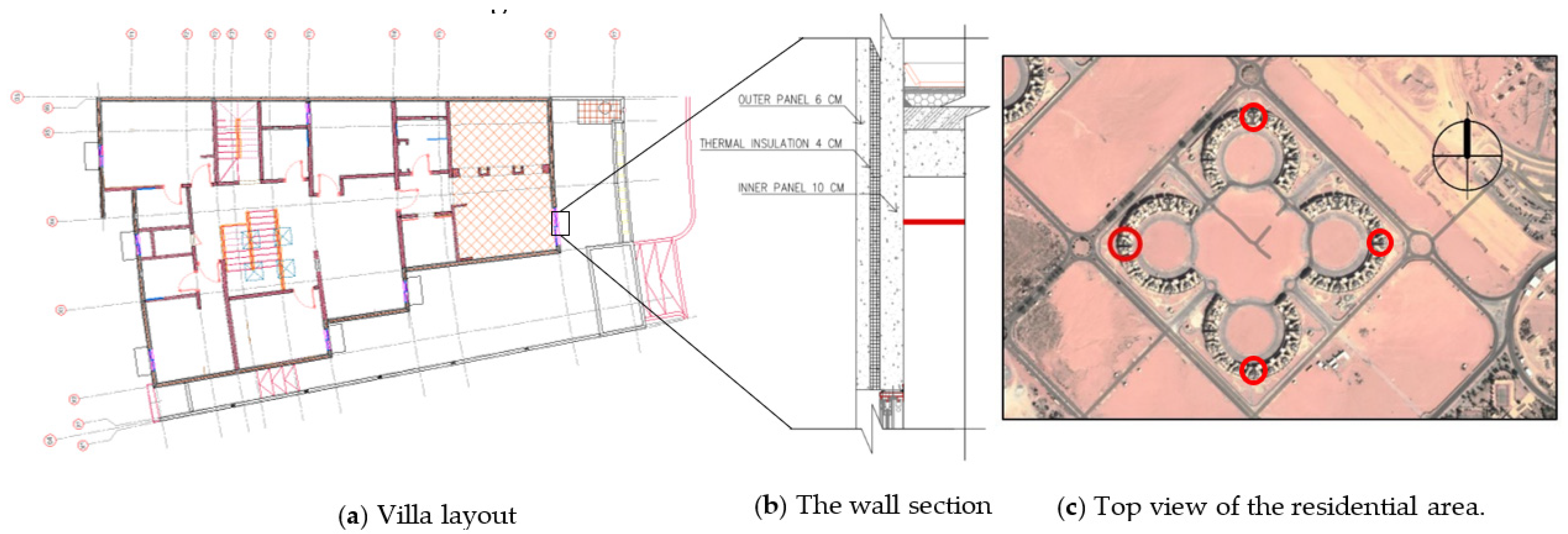


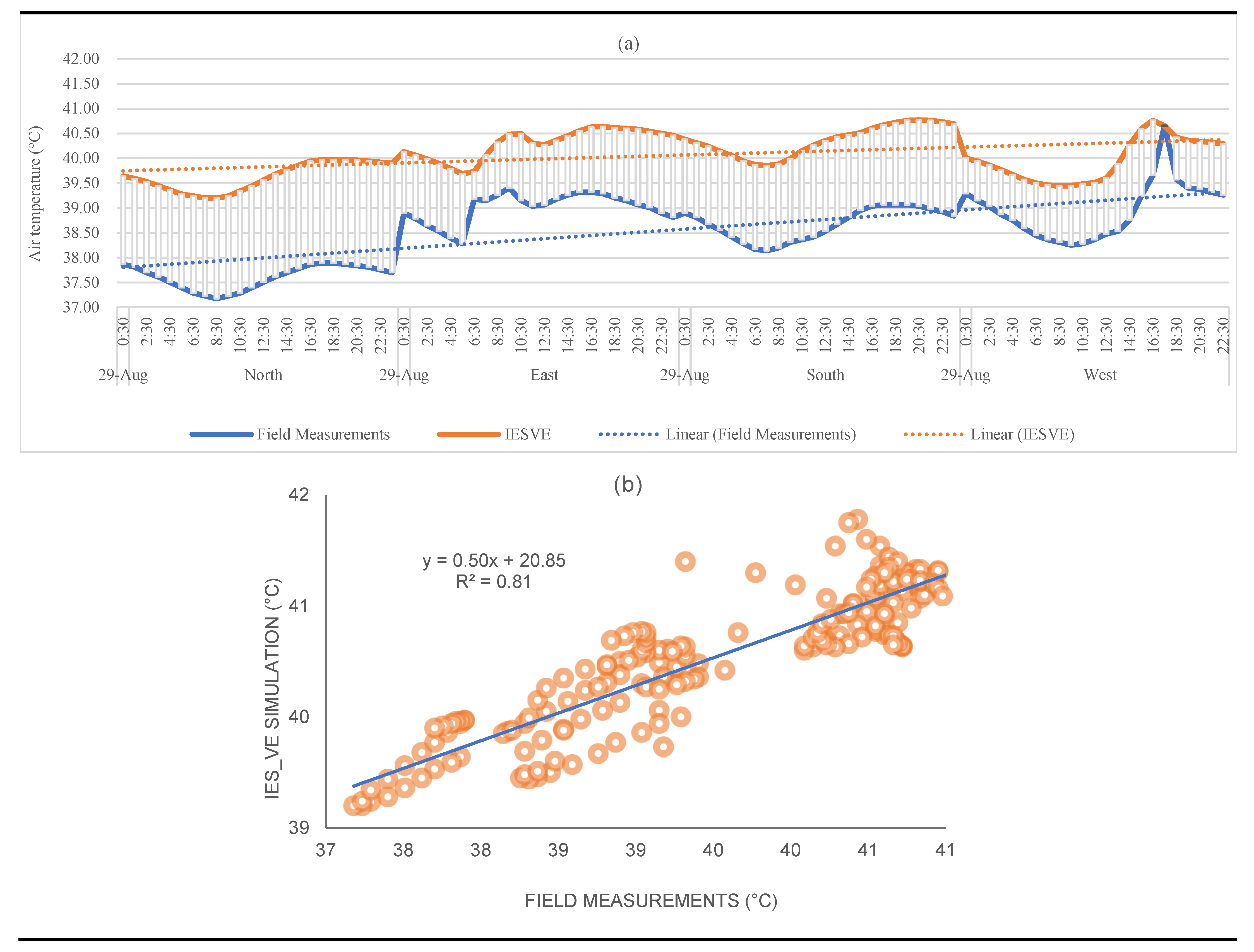
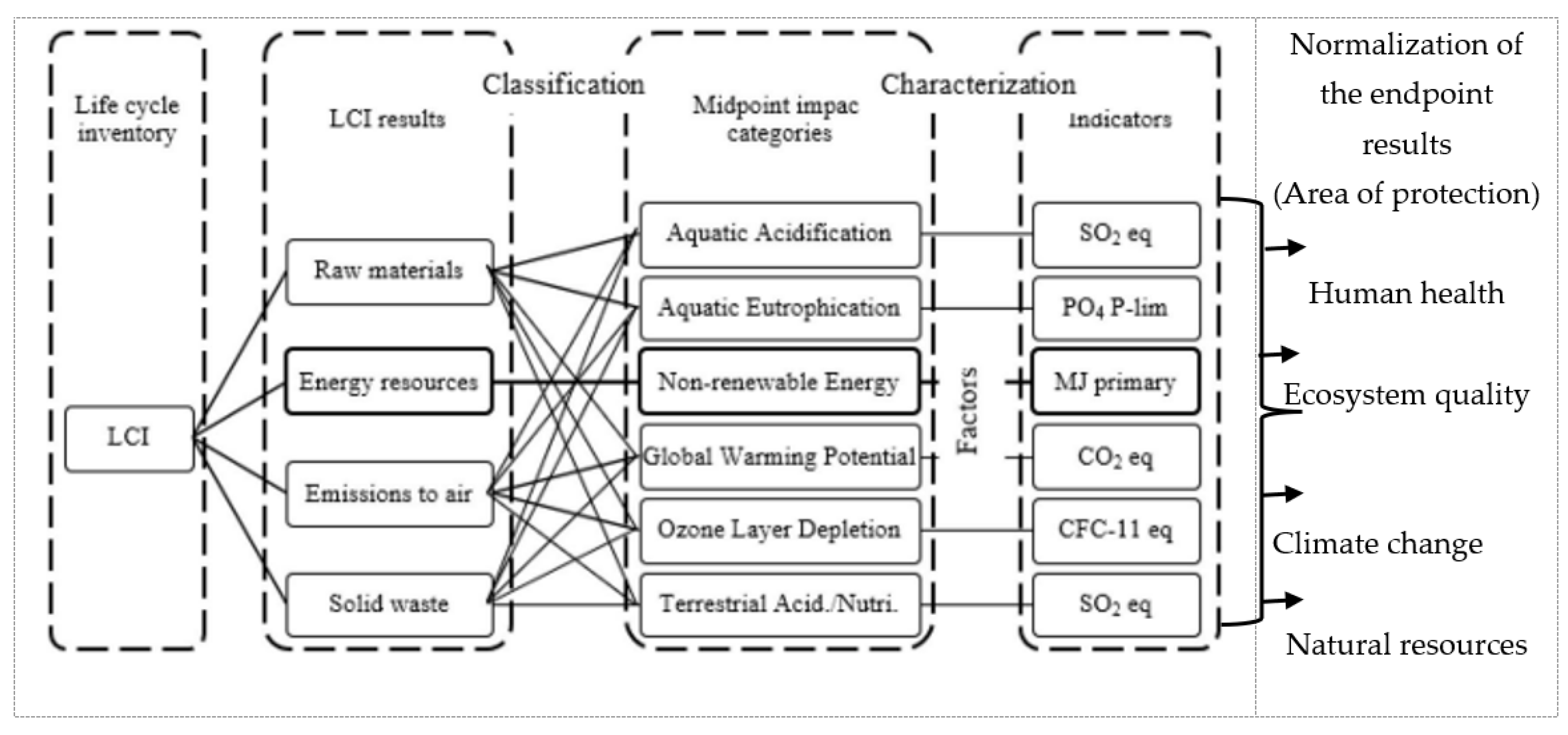


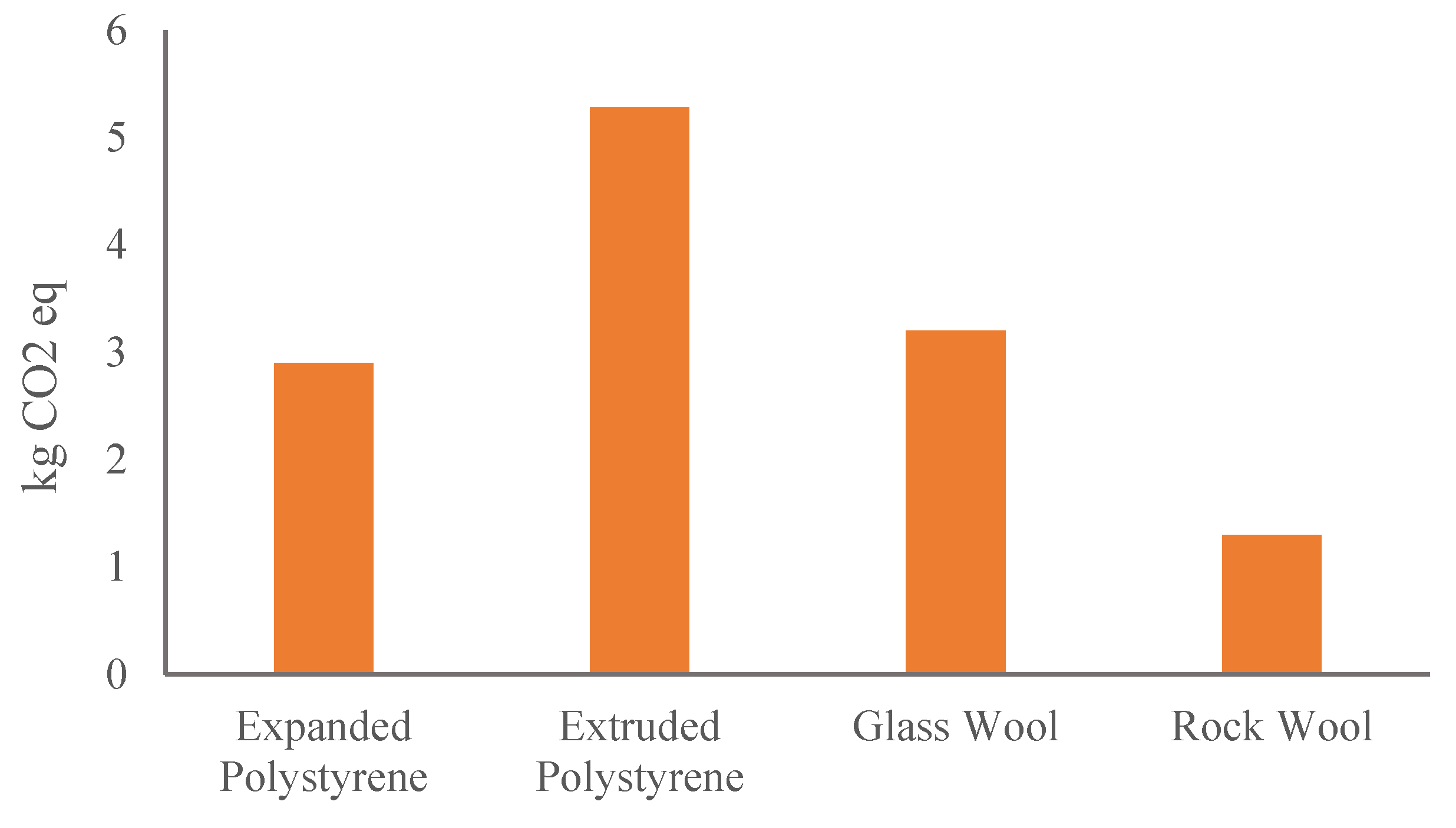


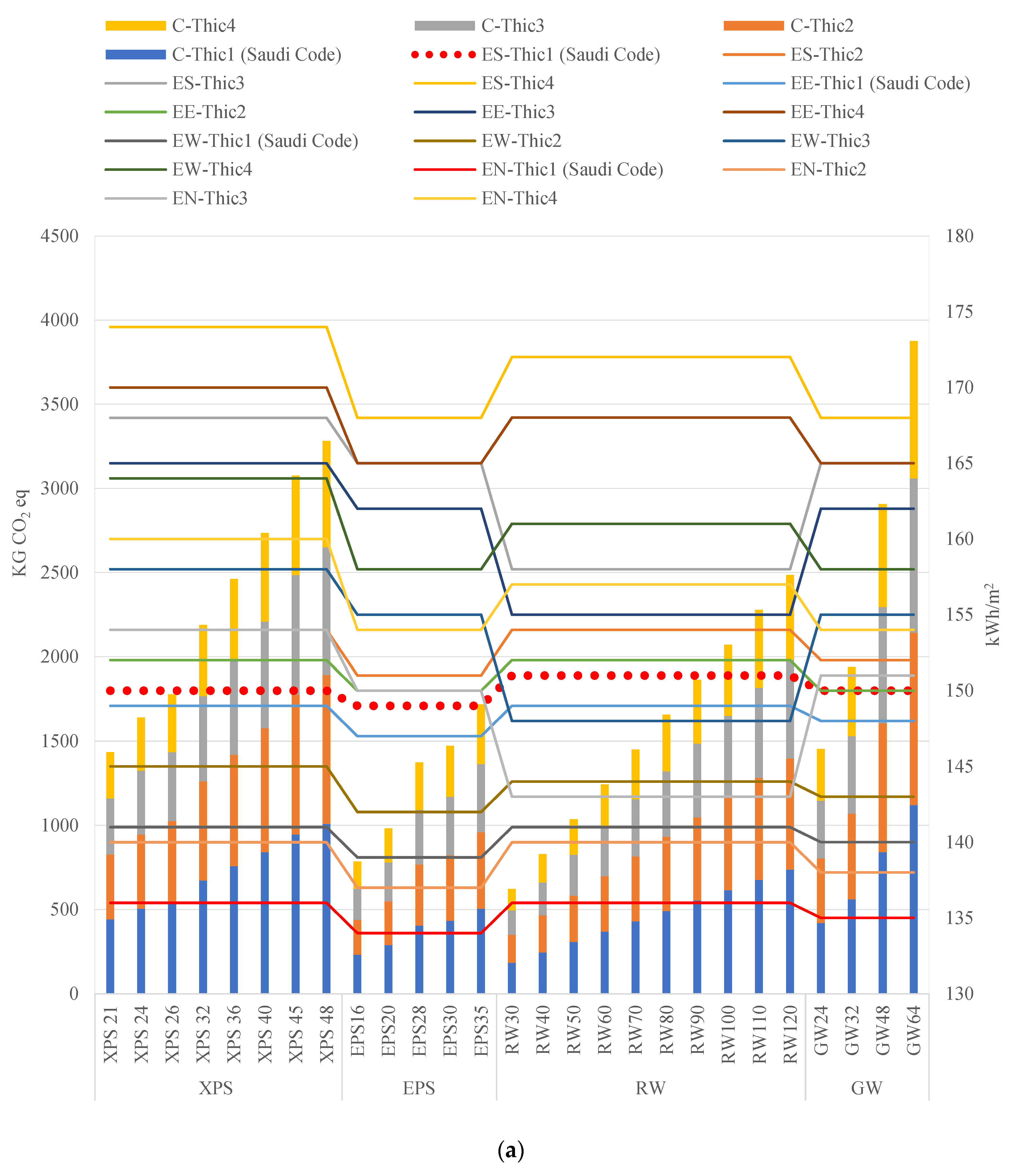

| Reference | Parameters Included | Methods Used | Outcomes |
|---|---|---|---|
| [13] | AAC Blocks, Insulating Plaster, and Reflective Coating | Infrared cameras, temperature/relative humidity sensors, U-value equipment |
|
| [25] | WWR | Experimental measurement, TAS EDSL |
|
| [26] | Environment, energy, economy c | Experimental measurement |
|
| [9] | Wall insulation, Roof insulation, WWR, window Shading, and thermal mass | Costs of life cycle Analysis Energy cost savings |
|
| [27] | Masonry bricks | Experimental measurement |
|
| [28] | External Walls R-Value | Thermal and economic analyses |
|
| [29] | EPS Wood fibre Rockwool GW | Simulation, TRNSYS |
|
| [30] | Walls installations Roof installations Window GHG emissions EE consumption | AccuRate V2.0.2.13SP2 |
|
| [31] | thermal admittance, steady thermal transmittance, surface mass, thickness | MatLab rel. 7.0 FRONTIER rel. 4.3 |
|
| [32] | thermal resistance thermal transmittance two exterior reinforced pre-cast concrete walls | Experimental measurement |
|
| [33] | pre-cast concrete sandwich panels | Lab Experimentation “hot plate apparatus” |
|
| Element | Construction | U-Value (W/m².k) |
|---|---|---|
|
External wall with XPS Insulation | Pre-cast Concrete 20 cm: Outer panel 6 cm Insulation 4 cm Inner panel 10 cm | 0.2780 |
| Internal Wall | Concrete Brick wall | 2.63 |
| Roof | Tile finish Waterproof membrane Concrete deck Insulation Plasterboard | 0.202 |
|
Glazing (Aluminum Frame) | Double Glazing Outer pane 6 mm Cavity 12 mm Inner pane 6 mm | 2.032 SHGC 0.25 |
| Ceiling/Flooring | Porcelain tile finish Reinforced concrete Plasterboard | 0.397 |
| Wall | Wall Insulation | U-Value (W/m². k) | Orientation | Required U-Value by SBC-602 | |
|---|---|---|---|---|---|
| Type | Thickness (mm) | ||||
| Outer Pane: 60 mm Inner Pane: 100 mm | EXP—5.28 Kg Co2 eq. | 50 60 70 80 90 | 0.5107 0.4364 0.3810 0.3381 0.3038 | N E S W | 0.342 |
| GW—3.2 Kg Co2 eq. | 80 90 100 110 120 | 0.4364 0.3935 0.3582 0.3288 0.3038 | |||
| EPS—2.9 Kg Co2 eq. | 70 80 90 100 110 | 0.4364 0.3880 0.3493 0.3176 0.2912 | |||
| RW—1.3 Kg Co2 eq. | 65 75 85 95 105 | 0.4769 0.4211 0.3770 0.3413 0.3117 | |||
| Thickness | Benchmark is 151 kWh/m2 | |||
|---|---|---|---|---|
| North | East | South | West | |
| The highest value of cooling loads for XPS insulation materials facing the South, benchmark = 151 kWh/m2 | ||||
| XPS 50 mm | 160 | 171 | 175 | 164 |
| XPS 60 mm | 155 | 166 | 169 | 159 |
| XPS 70 mm | 140 | 153 | 155 | 145 |
| XPS 80 mm | 136 | 149 | 151 | 141 |
| XPS 90 mm | 133 | 147 | 148 | 138 |
| The highest value of cooling loads for GW insulation materials facing the South. Benchmark = 150 kWh/m2 | ||||
| GW 80 mm | 155 | 166 | 169 | 159 |
| GW 90 mm | 151 | 163 | 165 | 156 |
| GW 100 mm | 138 | 151 | 153 | 143 |
| GW 110 mm | 136 | 149 | 150 | 141 |
| GW 120 mm | 133 | 147 | 148 | 138 |
| The highest value of cooling loads for EPS insulation materials facing the South, Benchmark = 149 kWh/m2 | ||||
| EPS 70 mm | 155 | 166 | 169 | 159 |
| EPS 80 mm | 151 | 163 | 165 | 155 |
| EPS 90 mm | 137 | 150 | 152 | 142 |
| EPS 100 mm | 135 | 148 | 149 | 140 |
| EPS 110 mm | 132 | 146 | 147 | 137 |
| The highest value of cooling loads for RW insulation materials facing the South, Benchmark = 151 kWh/m2 | ||||
| RW 65 mm | 157 | 168 | 172 | 161 |
| RW 75 mm | 143 | 155 | 158 | 148 |
| RW 85 mm | 140 | 152 | 154 | 144 |
| RW 95 mm | 136 | 149 | 151 | 141 |
| RW 105 mm | 134 | 147 | 148 | 139 |
Disclaimer/Publisher’s Note: The statements, opinions and data contained in all publications are solely those of the individual author(s) and contributor(s) and not of MDPI and/or the editor(s). MDPI and/or the editor(s) disclaim responsibility for any injury to people or property resulting from any ideas, methods, instructions or products referred to in the content. |
© 2023 by the authors. Licensee MDPI, Basel, Switzerland. This article is an open access article distributed under the terms and conditions of the Creative Commons Attribution (CC BY) license (https://creativecommons.org/licenses/by/4.0/).
Share and Cite
Alsaqabi, Y.; Almhafdy, A.; Haider, H.; Ghaffarianhoseini, A.; Ghaffarianhoseini, A.; Ali, A.A.M. Techno-Environmental Assessment of Insulation Materials in Saudi Arabia: Integrating Thermal Performance and LCA. Buildings 2023, 13, 331. https://doi.org/10.3390/buildings13020331
Alsaqabi Y, Almhafdy A, Haider H, Ghaffarianhoseini A, Ghaffarianhoseini A, Ali AAM. Techno-Environmental Assessment of Insulation Materials in Saudi Arabia: Integrating Thermal Performance and LCA. Buildings. 2023; 13(2):331. https://doi.org/10.3390/buildings13020331
Chicago/Turabian StyleAlsaqabi, Yazeed, Abdulbasit Almhafdy, Husnain Haider, Amirhosein Ghaffarianhoseini, Ali Ghaffarianhoseini, and Ahmed AbdelMonteleb M. Ali. 2023. "Techno-Environmental Assessment of Insulation Materials in Saudi Arabia: Integrating Thermal Performance and LCA" Buildings 13, no. 2: 331. https://doi.org/10.3390/buildings13020331
APA StyleAlsaqabi, Y., Almhafdy, A., Haider, H., Ghaffarianhoseini, A., Ghaffarianhoseini, A., & Ali, A. A. M. (2023). Techno-Environmental Assessment of Insulation Materials in Saudi Arabia: Integrating Thermal Performance and LCA. Buildings, 13(2), 331. https://doi.org/10.3390/buildings13020331












